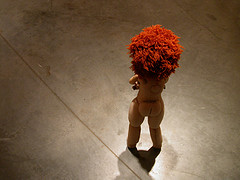
Without being too much the department of redundancy department I want to add a few things to what Libby said about the shows at the DCCA.
Adam Parker Smith‘s dolls and faces are sweet. As Libby said, the gender clash and nagging self-doubt apparent in some of his previous works is gone here. There still seems to be some questioning and questing going on. After all, a wall of faces, many of which look the same, reflects the artist ruminating on the nature of character and the essence of being. (image is one of Parker Smith’s dolls. You can see more images and see them bigger at my flickr site.)
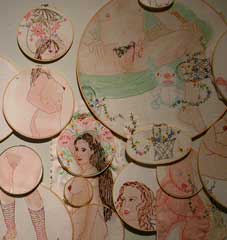
I want to mention here that embroidery and sewing are hot (body parts are always hot) and cropped up again recently at the O show at SICA. The work, by Orly Cogan, was not sweet at all. Cogan’s wall-spanning installation of embroidery-hooped, stitched- and painted-bodies was a little arch and ironic and actually kind of humor-less. (image is detail) But you can’t deny there’s stitchery in the air. We’ll have more about the big O in the near future.
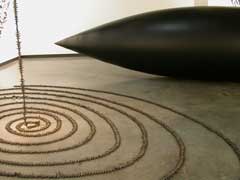
Back to DCCA. Ron Klein‘s work looks better than ever. His installation is a glorious merger of nature with all those pods collected from around the world and then mixed up with man-made intrusions like the pointy, poke-y inflatable. (image is detail of Klein’s installation)
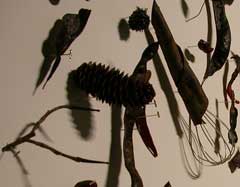
Klein’s wall pieces are decorative and simpler than I remember from his Pentimenti show. His diamond, swirl or circle motifs on the walls, built from many pods and pod/tool hybrids and pinned, specimen-like, to the walls have a shamanistic feel to them, something that truly mixes art with life and calls it one. I love this work and I think this is the best installation of Klein’s I’ve seen in recent memory. (image is closeup detail showing a kitchen utensil merged with some natural material.)
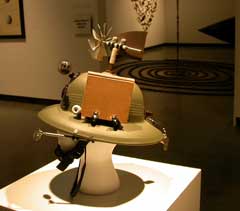
The surprise for me was the retrospective on Gretchen Hupfel, an artist who died early and by her own hand, something hinted at in the wall material and videos but confirmed to me by a brief encounter with her mother in the gallery.
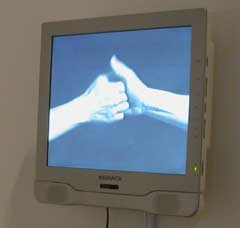
Hupfel was a questing soul and her room-spanning exhibit, accompanied by a catalog, has the feel of Dona Quixote, a woman battling the elements and battling her way through life’s big and small moments looking for poetry, love, perfection, companionship and answers. I loved much of the work, from the Daily Safari hat (pictured above) equipped with everyhting needed for a walk around the block; to the video piece of a thumb wrestling match (image below the hat image) that seemed to me to capture something about one of humanity’s greatest characteristics — the ability to make a game out of nothing and make it stand for something. The piece is so simple and so metaphorical it captures the battle of life in two clasped hands. It’s somehow genius.
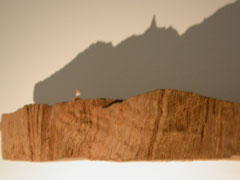
The artist made prints, took photos, was an early digital art practitioner, and sculpted. Hers was a restless intelligence and her object-making was superb. (image is Hupfel’s small installation using what looks like an HO scale female figure sitting on the edge of a precipice. The existentialism in the work was present in all her pieces.)
Finally, I’ll throw this out there and take some feedback.
I’ve been to the DCCA three or four times now and every time the experience left me happy but somehow dissatisfied. The art I’ve seen is pretty much always good quality. And yet the ambiance of the place — large expensively-retrofitted warehouse/kunsthalle with exposed ductwork, high ceilings and a rabbit warren of gallery spaces — leaves me wanting more edgier stuff on the walls and in the galleries, things like you might see at the ICA. I know it’s not fair to compare ICA and DCCA because the ICA is an academic institution with a mission to show the world’s best contemporary art — and it has some kind of museum-class budget. And DCCA is a community art center whose mission is to serve its members and the local community. I’m just saying that DCCA’s architectural grandeur suggests museum. And sometimes — the art doesn’t.
Perhaps the better comparison is between DCCA and Chelsea galleries where often you find grand spaces and art that is sometimes grand and sometimes not.









